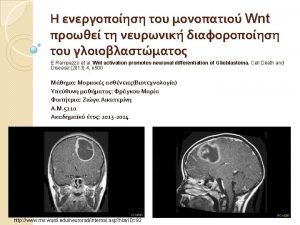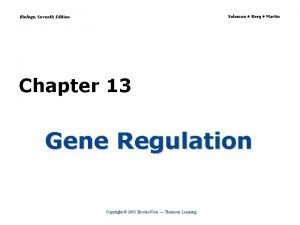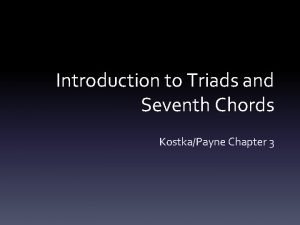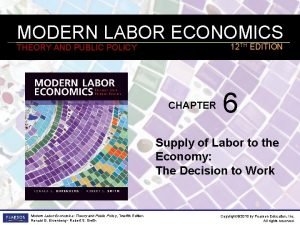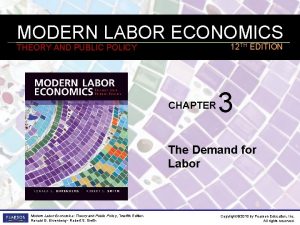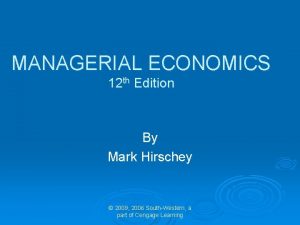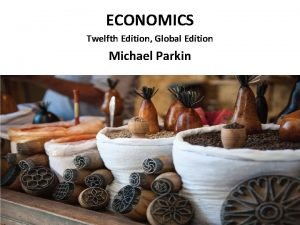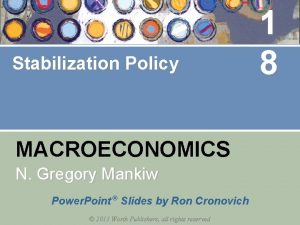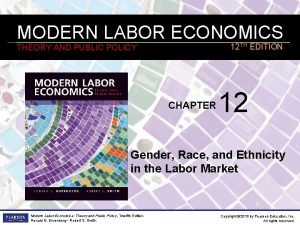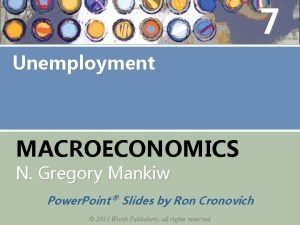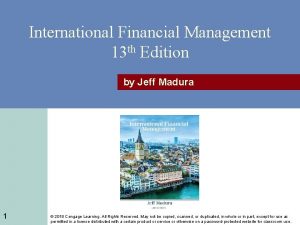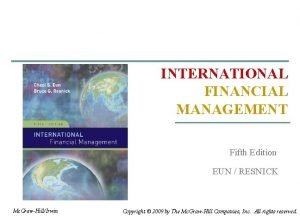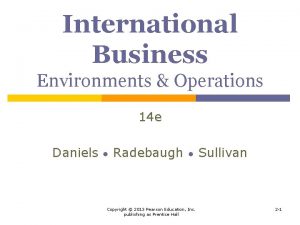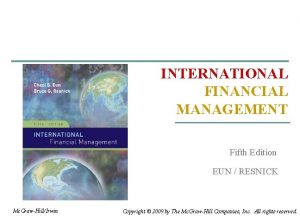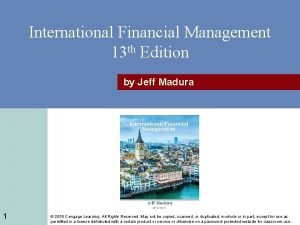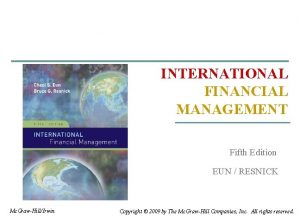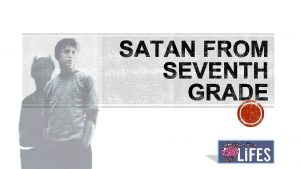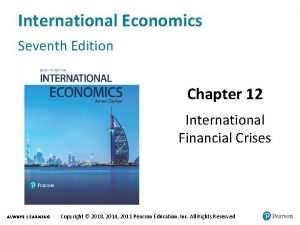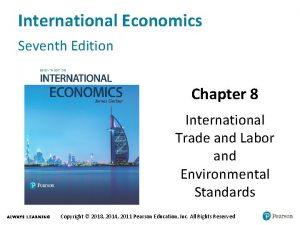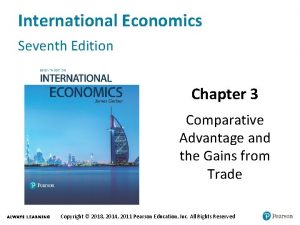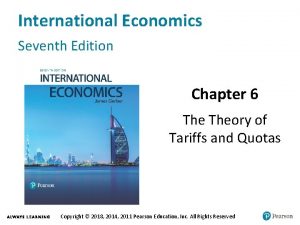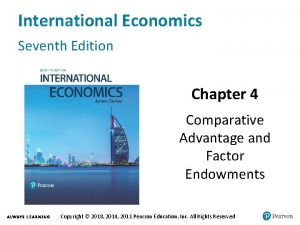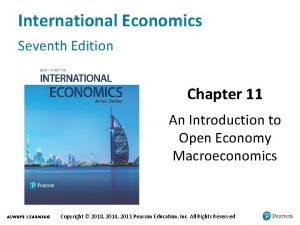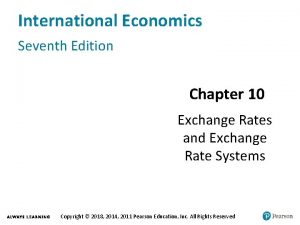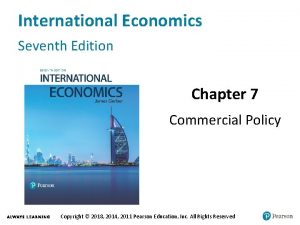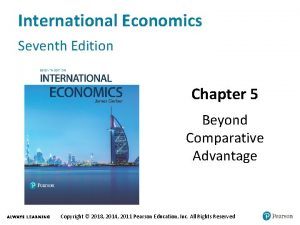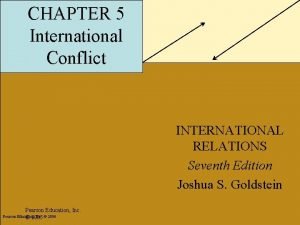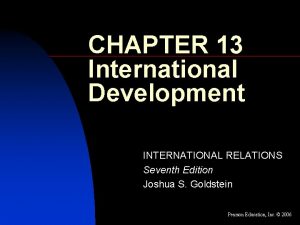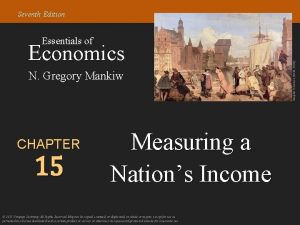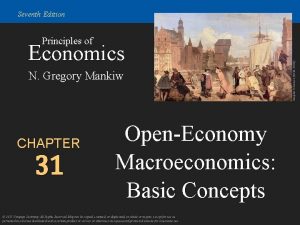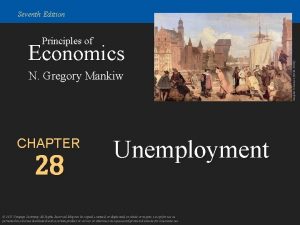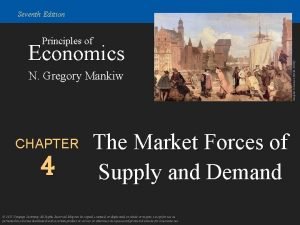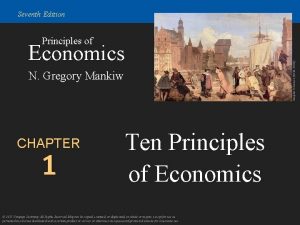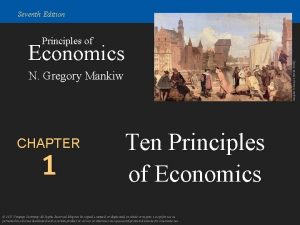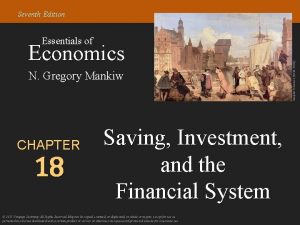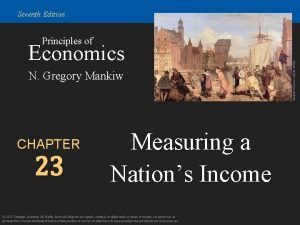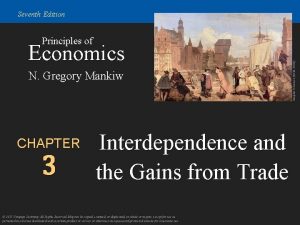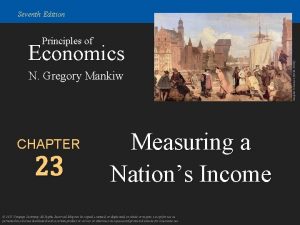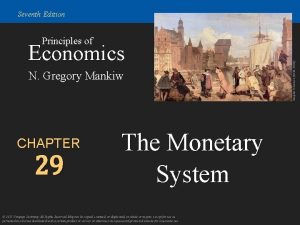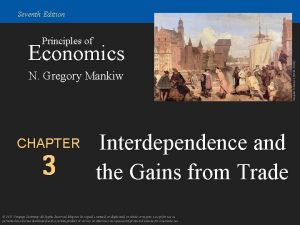International Economics Seventh Edition Chapter 2 International Economics

























- Slides: 25

International Economics Seventh Edition Chapter 2 International Economics Institutions Since World War II Copyright © 2018, 2014, 2011 Pearson Education, Inc. All Rights Reserved

Learning Objectives (1 of 2) 2. 1 Classify with examples the main types of international economic organizations. 2. 2 Identify economic circumstances in which the IMF, the World Bank, and the WTO are active. 2. 3 Compare the different levels of integration found in regional trade agreements with examples. Copyright © 2018, 2014, 2011 Pearson Education, Inc. All Rights Reserved

Learning Objectives (2 of 2) 2. 4 Analyze the roles of international economic organizations. 2. 5 Debate the pros and cons of international organizations. Copyright © 2018, 2014, 2011 Pearson Education, Inc. All Rights Reserved

International Institutions since World War II • Economists define institutions as the rules that govern and constrain behavior. • Institutions define what is permitted and what is prohibited. • Institutions can be formal or informal. – Formal institutions are written, often embodied in laws, codes, constitutions. – Informal are customs or tradition such as manners and etiquette. • Formal institutions are often be embodied in a organization. Copyright © 2018, 2014, 2011 Pearson Education, Inc. All Rights Reserved

Table 2. 1: Categories of International Institutions, with Examples Type Examples Commodity- or industry-specific organizations: These range from trade associations, to international standards-setting bodies, to powerful cartels Oil Producing and Exporting Countries (OPEC) International Telecommunications Union (ITU) Commissions and agencies for managing shared International Boundary and Water resources Commission (IBWC) Mekong River Commission Development funds and banks Asian Development Bank Islamic Development Bank International trade agreements involving a few North American Free Trade Agreement nations (regional trade alliances or trade blocs) (NAFTA) European Union Global organizations for trade, development, International Monetary Fund (IMF) and macroeconomic stability World Bank World Trade Organization (WTO) Copyright © 2018, 2014, 2011 Pearson Education, Inc. All Rights Reserved

The IMF, the World Bank, and the WTO • Three international organizations play major roles in international economic relations: – The International Monetary Fund (IMF) – The World Bank – The World Trade Organization (WTO) Copyright © 2018, 2014, 2011 Pearson Education, Inc. All Rights Reserved

The Bretton Woods Conference • The Bretton Woods Conference, held in 1944 at Bretton Woods, New Hampshire, was a gathering of leaders from the Allied Powers. – The goal was to create a more stable and prosperous world economy. – They wished to avoid the problems of the 1930 s by creating institutions and organizations that would define rules for trade and international payments. Copyright © 2018, 2014, 2011 Pearson Education, Inc. All Rights Reserved

The IMF (1 of 2) • The IMF was created at Bretton Woods in 1944. • It began operation in 1945 with 29 members; today it has 188. • It is funded by a quota each member pays; the quota is proportional to the size of their economy and determines how many votes it has. • The primary purpose of the IMF is to assist in the creation of a stable, crisis free, system of international payments between countries. • Its main activities are to provide technical and financial assistance to countries that have debt problems or an unstable currency. Copyright © 2018, 2014, 2011 Pearson Education, Inc. All Rights Reserved

The IMF (2 of 2) • The IMF is an international lender of last resort. – It provides loans to countries that cannot make payments on their debts and that cannot borrow elsewhere. – The loans are limited in size and come with a set of requirements, called IMF conditionality. • The IMF monitors exchange rates and assists countries when their currencies collapse in value. • An increasingly important role is to provide standards and technical assistance for the international reporting of economic and financial data. Copyright © 2018, 2014, 2011 Pearson Education, Inc. All Rights Reserved

The World Bank • Also created at Bretton Woods with a membership and structure similar to the IMF. • Countries buy shares and the number of shares determines their voting rights. • Originally intended as a mechanism to rebuild Europe after World War II • Its main function today is to provide capital and technical assistance for economic development. Copyright © 2018, 2014, 2011 Pearson Education, Inc. All Rights Reserved

The GATT (1 of 4) • The General Agreement on Tariffs and Trade (GATT) was envisioned at Bretton Woods but did not start until 1950. • Its main purpose is to provide a forum for discussing trade rules and a mechanism for gradually opening markets to more international trade. • The GATT works through trade rounds. – Trade rounds are formal discussions about new rules for reducing trade barriers. Copyright © 2018, 2014, 2011 Pearson Education, Inc. All Rights Reserved

The GATT (2 of 4) • Initially the GATT focused on proportional tariff reductions and elimination of quotas. – It did not promote free trade, it promoted “freer” trade. – Proportional tariff reductions require each country to reduce tariffs by the same percentage but tariffs remain different. • By the 1970 s, new issues arose that required discussion and negotiations: – Subsidies for industry that gave advantages; – Problems of selling goods at artificially low prices; – Barriers to trade in new areas, such as services Copyright © 2018, 2014, 2011 Pearson Education, Inc. All Rights Reserved

The GATT (3 of 4) • The Uruguay Round was a new set of rules that began in 1995. – It created the World Trade Organization to serve as the umbrella organization for all agreements. – It extended trade agreements into services, agriculture, patent protections, international investment rules, and others. • In 2001, the Doha Round opened discussion. – Its primary focus was meant to be on the issues of concern to developing countries. – It proposed a Doha Development Agenda – It is the first round of talks to fail; a major reason is the inability of advanced economies to lower their trade barriers in agriculture. Copyright © 2018, 2014, 2011 Pearson Education, Inc. All Rights Reserved

The GATT (4 of 4) • The GATT remains in effect and is the primary agreement overseen by the WTO. • The two guiding principles of the GATT are national treatment and nondiscrimination. – National treatment means that foreign goods must be treated the same as national goods. – Nondiscrimination prohibits different tariffs or rules for different countries. This is the principle of most favored nation status. • All WTO members must adhere to these rules when trading with other WTO members. Copyright © 2018, 2014, 2011 Pearson Education, Inc. All Rights Reserved

Table 2. 2 The GATT Rounds Round Year Geneva I 1947 23 Annecy 1949 13 Torquay 1951 38 Geneva II 1956 26 Dillon 1960– 1961 26 Kennedy 1964– 1967 62 Tokyo 1973– 1979 102 Uruguay 1986– 1993 105 2001– 162 Doha (WTO) Number of Participants Copyright © 2018, 2014, 2011 Pearson Education, Inc. All Rights Reserved

Regional Trade Agreements (1 of 5) • Regional trade agreements (RTA) can be: – Bilateral (two members); – Plurilateral (several members); – Multilateral (open to everyone that wants to join). • There are five levels of RTA: – Partial agreement – Free trade area – Customs union – Common market – Economic union Copyright © 2018, 2014, 2011 Pearson Education, Inc. All Rights Reserved

Regional Trade Agreements (2 of 5) • Each level increases in complexity and includes the prior levels. • Partial agreement: Free trade in one or a few products. • Free trade area: Free trade in all goods and services (outputs). • Customs union: An FTA plus a common external tariff. • Common market: A customs union plus free movement of labor and capital (inputs). • Economic union: A common market plus substantial harmonization of economic policies. Copyright © 2018, 2014, 2011 Pearson Education, Inc. All Rights Reserved

Regional Trade Agreements (3 of 5) • Examples of prominent RTA: – North American Free Trade Agreement (NAFTA); – Common Market of the South (Mercosur); – ASEAN Free Trade Area (AFTA); – Economic Community of West African States (ECOWAS); – Gulf Cooperation Council (GCC); – The European Union (EU). Copyright © 2018, 2014, 2011 Pearson Education, Inc. All Rights Reserved

Regional Trade Agreements (4 of 5) • RTA have grown in number. In 2012, 338 were active, most of them created since 1990. • Most agreements have exceptions: free trade agreements do not usually have 100% free trade. • RTA violate the nondiscrimination rule of the GATT and WTO; countries treat member countries better than others. – The WTO allows this as long as trade creation is greater than trade diversion. – Trade creation: New trade created by the agreement; – Trade diversion: Trade that is diverted from a nonmember to a member. Copyright © 2018, 2014, 2011 Pearson Education, Inc. All Rights Reserved

Regional Trade Agreements (5 of 5) • Proponents of RTA claim the following: – They help world trade by reducing some barriers; – They allow countries to try new agreements that can potentially be used later in WTO negotiations; – They encourage WTO agreement by offering an alternative in case the WTO is stalled. • Opponents argue: – They divert attention from multilateral negotiations and undermine the WTO; – They rarely, if ever, lead to a WTO agreement; – They often discriminate against poorer nations. Copyright © 2018, 2014, 2011 Pearson Education, Inc. All Rights Reserved

Why Have International Institutions? • International institutions provide public goods. – Public goods are nonexcludable: Everyone benefits even if they do not pay. – Public goods are nonrival (nondiminishable): They are not diminished by consuming them. – Public goods have a free rider problem. • The two most important characteristics of public goods provided by international institutions are: – Increased international economic order; – Increased certainty about the behavior of other nations. Copyright © 2018, 2014, 2011 Pearson Education, Inc. All Rights Reserved

Four Public Goods Provided by International Institutions • Open markets in recessions (GATT/WTO); • Capital flows to less-developed countries (World Bank); • International money for paying international debts (IMF); • Last resort lending (IMF). Copyright © 2018, 2014, 2011 Pearson Education, Inc. All Rights Reserved

Criticisms of International Institutions (1 of 2) • Sovereignty and transparency. – Countries receiving assistance, particularly from the IMF, are sometimes required to give up the ability to set their own policies. – Decision making in the institutions is not transparent; because the U. S. and Europe have the largest voting bloc, decisions are sometimes viewed as having been directed by rich countries. Copyright © 2018, 2014, 2011 Pearson Education, Inc. All Rights Reserved

Criticisms of International Institutions (2 of 2) • Ideology. – Critics argue that the advice, technical assistance, and negotiating positions are often a reflection of the biases and ideologies of high income countries and do not adequately consider alternative policies. • Implementation and adjustment costs. – There asymmetries in the fiscal burdens associated with implementing agreements and adjusting to the changes they create; richer countries do better at this than poorer ones. Copyright © 2018, 2014, 2011 Pearson Education, Inc. All Rights Reserved

Copyright © 2018, 2014, 2011 Pearson Education, Inc. All Rights Reserved
 3 layers of muscle
3 layers of muscle Chords rule in dbms
Chords rule in dbms Principles of information systems, seventh edition
Principles of information systems, seventh edition Molecular biology of the cell seventh edition
Molecular biology of the cell seventh edition Biology seventh edition
Biology seventh edition Seventh chord inversions
Seventh chord inversions Mis chapter 6
Mis chapter 6 Using mis 10th edition
Using mis 10th edition Principle of management oxford fajar pdf
Principle of management oxford fajar pdf Modern labor economics 12th edition solution
Modern labor economics 12th edition solution Modern labor economics 12th edition
Modern labor economics 12th edition Economics michael parkin 13th edition
Economics michael parkin 13th edition Managerial economics hirschey
Managerial economics hirschey Parkin economics 12th edition
Parkin economics 12th edition Principles of economics mankiw 9th edition ppt
Principles of economics mankiw 9th edition ppt Rational people think at the margin
Rational people think at the margin Modern labor economics 12th edition
Modern labor economics 12th edition Principles of economics mankiw 9th edition ppt
Principles of economics mankiw 9th edition ppt International financial management jeff madura 13th edition
International financial management jeff madura 13th edition International financial management 5th edition
International financial management 5th edition Religion as a cultural stabilizer
Religion as a cultural stabilizer International human resource management dowling 6th edition
International human resource management dowling 6th edition Goals of international financial management
Goals of international financial management International financial management 13th edition
International financial management 13th edition International financial management 5th edition
International financial management 5th edition The devil from seventh grade
The devil from seventh grade



